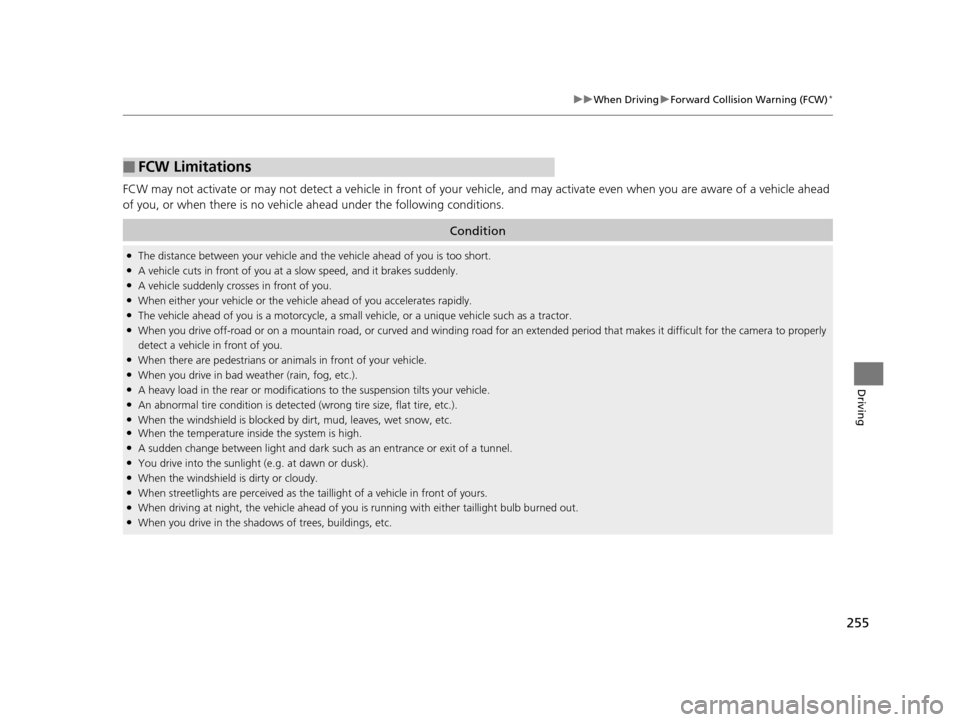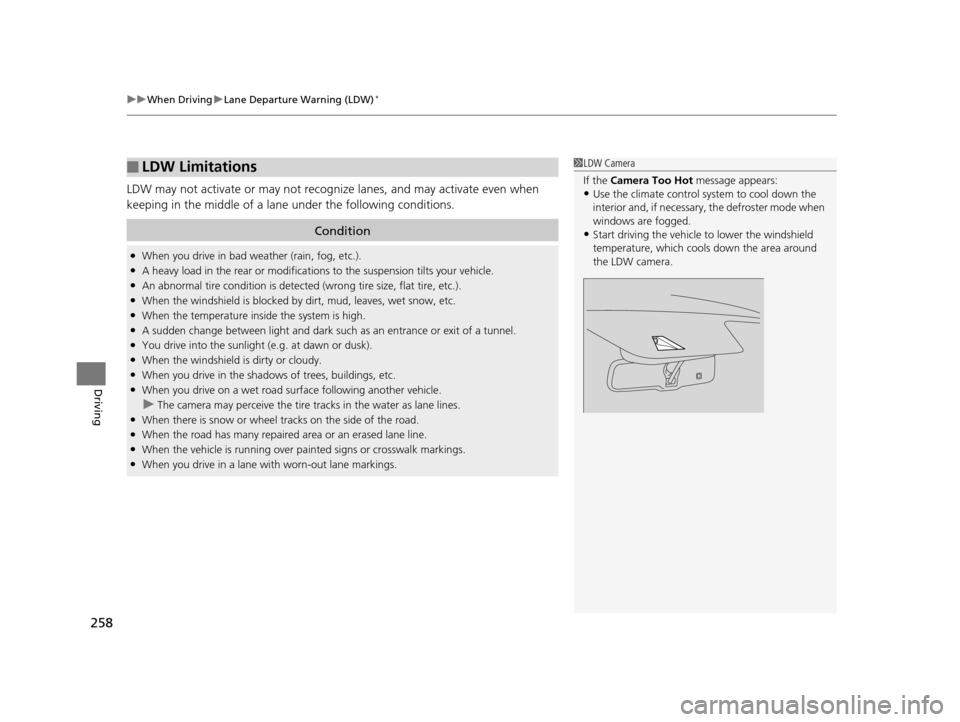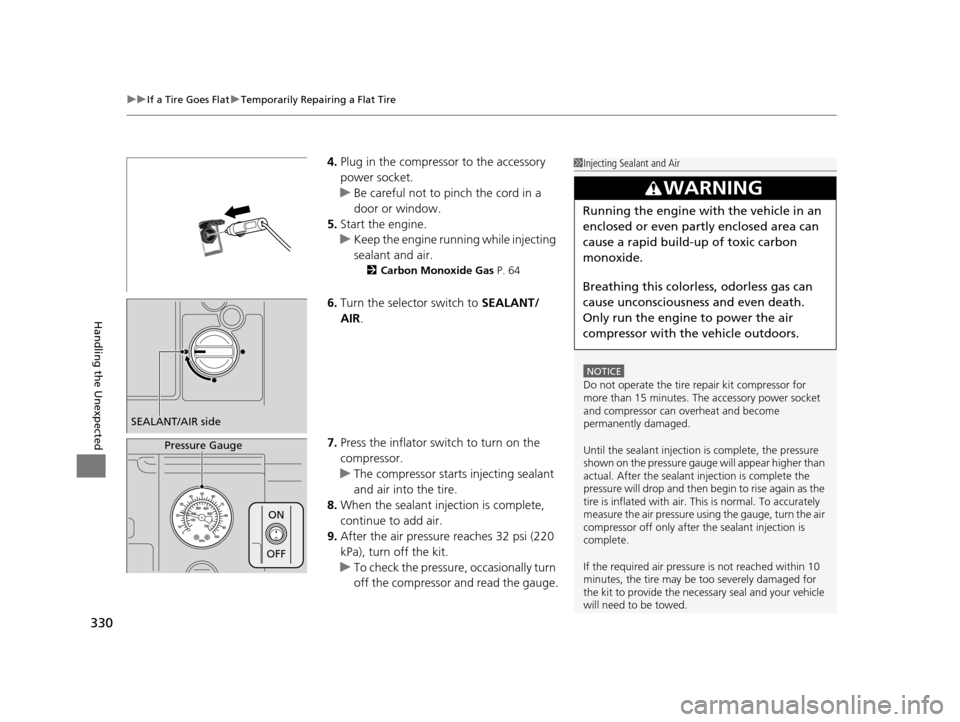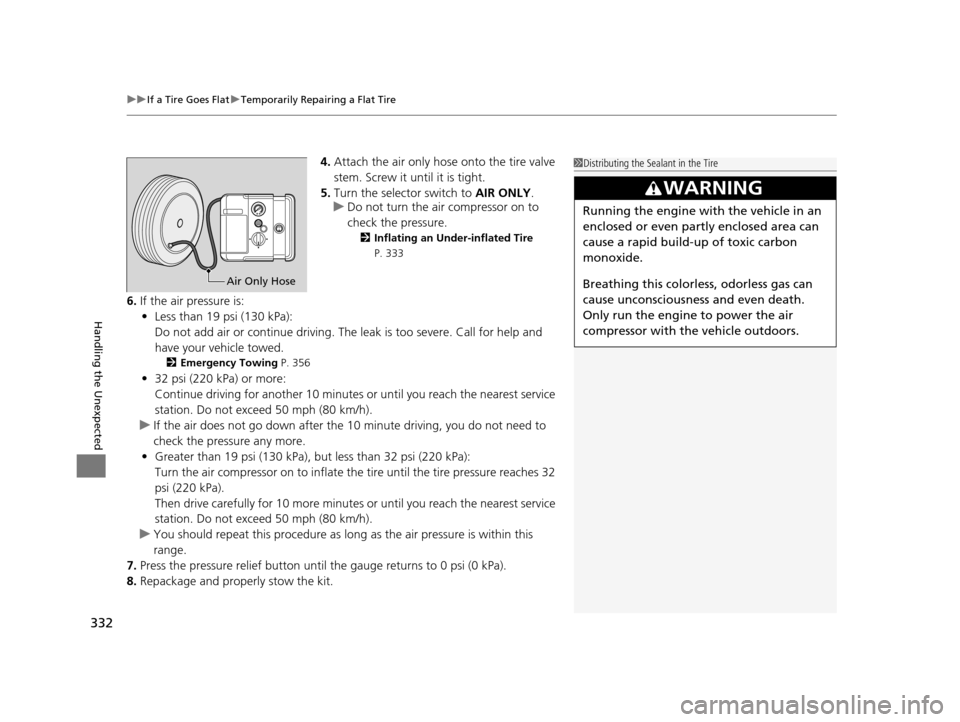Page 22 of 377
Quick Reference Guide
21
Handling the Unexpected (P325)
Flat Tire (P327)
● Park in a safe location and repair the flat
tire using the temporary tire repair kit.
● Park in a safe location and replace the
flat tire with the comp act spare tire in the
trunk.
Indicators Come On
(P349)
● Identify the indica tor and consult the
owner’s manual.
Models with an optional compact spare tire
Engine Won’t Start (P341)
● If the battery is dead, jump start using a
booster battery.
Blown Fuse (P353)
● Check for a blown fuse if an electrical
device does not operate.
Overheating (P347)
● Park in a safe location. If you do not see
steam under the hood, open the hood,
and let the engine cool down.
Emergency Towing (P356)
● Call a professional towing service if you
need to tow your vehicle.
14 CIVIC IMA-31TR26200.book 21 ページ 2013年12月23日 月曜日 午後4時9分
Page 256 of 377

255
uuWhen Driving uForward Collision Warning (FCW)*
Driving
FCW may not activate or may not detect a vehicle in front of your vehicle, and may activate even when you are aware of a vehicle ahead
of you, or when there is no vehicle ahead under the following conditions.
■FCW Limitations
Condition
●The distance between your vehicle and the vehicle ahead of you is too short.●A vehicle cuts in front of you at a slow speed, and it brakes suddenly.●A vehicle suddenly crosses in front of you.●When either your vehicle or the vehicle ahead of you a ccelerates rapidly.●The vehicle ahead of you is a motorcycle, a small vehicle, or a unique vehicle such as a tractor.●When you drive off-road or on a mountain road, or curved and wi nding road for an extended period that makes it difficult for the camera to properly
detect a vehicle in front of you.
●When there are pedestrians or an imals in front of your vehicle.●When you drive in bad weather (rain, fog, etc.).●A heavy load in the rear or modificati ons to the suspension tilts your vehicle.●An abnormal tire condition is detected (wrong tire size, flat tire, etc.).●When the windshield is blocked by dirt, mud, leaves, wet snow, etc.●When the temperature inside the system is high.●A sudden change between light and dark such as an entr ance or exit of a tunnel.●You drive into the sunlight (e.g. at dawn or dusk).●When the windshield is dirty or cloudy.●When streetlights are perceived as the ta illight of a vehicle in front of yours.●When driving at night, the vehicle ahead of you is running with either taillight bulb burned out.●When you drive in the shadows of trees, buildings, etc.
14 CIVIC IMA-31TR26200.book 255 ページ 2013年12月23日 月曜日 午後4時9分
Page 259 of 377

uuWhen Driving uLane Departure Warning (LDW)*
258
Driving
LDW may not activate or may not recogniz e lanes, and may activate even when
keeping in the middle of a lane under the following conditions.
■LDW Limitations
Condition
●When you drive in bad weather (rain, fog, etc.).●A heavy load in the rear or modificati ons to the suspension tilts your vehicle.●An abnormal tire condition is detected (wrong tire size, flat tire, etc.).●When the windshield is blocked by dirt, mud, leaves, wet snow, etc.●When the temperature inside the system is high.●A sudden change between light and dark such as an entrance or exit of a tunnel.●You drive into the sunlight (e.g. at dawn or dusk).●When the windshield is dirty or cloudy.●When you drive in the shadows of trees, buildings, etc.●When you drive on a wet road su rface following another vehicle.
uThe camera may perceive the tire tracks in the water as lane lines.●When there is snow or wheel tracks on the side of the road.●When the road has many repaired area or an erased lane line.●When the vehicle is running over painted signs or cr osswalk markings.●When you drive in a lane with worn-out lane markings.
1LDW Camera
If the Camera Too Hot message appears:
•Use the climate control system to cool down the
interior and, if necessary , the defroster mode when
windows are fogged.
•Start driving the vehicle to lower the windshield
temperature, which cool s down the area around
the LDW camera.
14 CIVIC IMA-31TR26200.book 258 ページ 2013年12月23日 月曜日 午後4時9分
Page 302 of 377
301
uuReplacing Light Bulbs uDaytime Running Light Bulbs
Maintenance
1. Remove the holding clip using a flat-tip
screwdriver, then remo ve the upper part of
the windshield washer reservoir.
2. Push the tab to remove the coupler.
3. Rotate the old bulb to the left to remove.
4. Insert a new bulb into the headlight
assembly and turn it to the right.
5. Insert the coupler into the connector of the
bulb.
Daytime Running Light Bulbs
Daytime running light bulbs are LED type. Ha ve an authorized Honda dealer inspect
and replace the light assembly.
■Low Beam Headlights1 Low Beam Headlights
Insert a flat-tip screwdriver, lift and remove the
central pin to remove the clip.
Insert the clip with the central pin raised, and push
until it is flat.
Central pin
Push until the
pin is flat.
ClipPassenger’s side
Coupler
Driver’s and passenger’s side
14 CIVIC IMA-31TR26200.book 301 ページ 2013年12月23日 月曜日 午後4時9分
Page 305 of 377
304
uuReplacing Light Bulbs uBack-Up Light Bulbs
Maintenance
Back-Up Light Bulbs
When replacing, use the following bulbs.
1.Remove the screw from the center of the
fastener using a Phillips-head screwdriver.
2. Remove the holding clips using a flat-tip
screwdriver, then pull the lining back.
2Rear Turn Signal Light Bulbs P. 303
3.Turn the socket to the left and remove it.
4. Remove the old bulb and insert a new bulb.
Taillight Bulbs
Taillight bulbs in the trunk lid are LED type. Have an authorized Honda dealer inspect
and replace the light assembly.
Back-Up Light: 16 W
Lining
Fastener
Clip
Bulb Socket
14 CIVIC IMA-31TR26200.book 304 ページ 2013年12月23日 月曜日 午後4時9分
Page 329 of 377
uuIf a Tire Goes Flat uTemporarily Repairing a Flat Tire
328
Handling the Unexpected
1. Open the trunk floor lid.
2. Take the kit out of the case.
u Place the kit face up, on flat ground near
the flat tire, and away from traffic. Do
not place the kit on its side.1Getting Ready to Temporarily Repair the Flat Tire
When making a temporary repair, carefully read the
instruction manual provided with the kit.
In cold temperatures, the sealant may not flow easily.
In this situation, warm it up for five minutes before
using.
14 CIVIC IMA-31TR26200.book 328 ページ 2013年12月23日 月曜日 午後4時9分
Page 331 of 377

uuIf a Tire Goes Flat uTemporarily Repairing a Flat Tire
330
Handling the Unexpected
4. Plug in the compressor to the accessory
power socket.
u Be careful not to pinch the cord in a
door or window.
5. Start the engine.
u Keep the engine running while injecting
sealant and air.
2 Carbon Monoxide Gas P. 64
6.Turn the selector switch to SEALANT/
AIR .
7. Press the inflator switch to turn on the
compressor.
u The compressor starts injecting sealant
and air into the tire.
8. When the sealant inje ction is complete,
continue to add air.
9. After the air pressure reaches 32 psi (220
kPa), turn off the kit.
u To check the pressure , occasionally turn
off the compressor and read the gauge.
1 Injecting Sealant and Air
NOTICE
Do not operate the tire repair kit compressor for
more than 15 minutes. The accessory power socket
and compressor can ov erheat and become
permanently damaged.
Until the sealant injection is complete, the pressure
shown on the pressure gauge will appear higher than
actual. After the sealant injection is complete the
pressure will drop and then begin to rise again as the
tire is inflated with air. This is normal. To accurately
measure the air pressure usi ng the gauge, turn the air
compressor off only after the sealant injection is
complete.
If the required air pressure is not reached within 10
minutes, the tire may be too severely damaged for
the kit to provide the necessa ry seal and your vehicle
will need to be towed.
3WARNING
Running the engine with the vehicle in an
enclosed or even partly enclosed area can
cause a rapid build-up of toxic carbon
monoxide.
Breathing this colorless, odorless gas can
cause unconsciousness and even death.
Only run the engine to power the air
compressor with th e vehicle outdoors.
SEALANT/AIR side
Pressure Gauge
ON
OFF
14 CIVIC IMA-31TR26200.book 330 ページ 2013年12月23日 月曜日 午後4時9分
Page 333 of 377

uuIf a Tire Goes Flat uTemporarily Repairing a Flat Tire
332
Handling the Unexpected
4. Attach the air only hose onto the tire valve
stem. Screw it until it is tight.
5. Turn the selector switch to AIR ONLY.
u Do not turn the air compressor on to
check the pressure.
2 Inflating an Under-inflated Tire
P. 333
6. If the air pressure is:
• Less than 19 psi (130 kPa):
Do not add air or continue driving. Th e leak is too severe. Call for help and
have your vehicle towed.
2 Emergency Towing P. 356
•32 psi (220 kPa) or more:
Continue driving for another 10 minutes or until you reach the nearest service
station. Do not exceed 50 mph (80 km/h).
u If the air does not go down after the 10 minute driving, you do not need to
check the pressure any more.
• Greater than 19 psi (130 kPa), but less than 32 psi (220 kPa):
Turn the air compressor on to inflate the tire until the tire pressure reaches 32
psi (220 kPa).
Then drive carefully for 10 more minutes or until you reach the nearest service
station. Do not exceed 50 mph (80 km/h).
u You should repeat this procedure as lo ng as the air pressure is within this
range.
7. Press the pressure relief button until the gauge returns to 0 psi (0 kPa).
8. Repackage and properly stow the kit.
1Distributing the Sealant in the Tire
3WARNING
Running the engine with the vehicle in an
enclosed or even partly enclosed area can
cause a rapid build-up of toxic carbon
monoxide.
Breathing this colorless, odorless gas can
cause unconsciousness and even death.
Only run the engine to power the air
compressor with th e vehicle outdoors.
Air Only Hose
14 CIVIC IMA-31TR26200.book 332 ページ 2013年12月23日 月曜日 午後4時9分